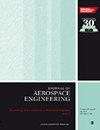基于簇状速度测量法的机翼表面流动结构测试研究
IF 1.1
4区 工程技术
Q3 ENGINEERING, AEROSPACE
Proceedings of the Institution of Mechanical Engineers Part G-Journal of Aerospace Engineering
Pub Date : 2024-08-18
DOI:10.1177/09544100241274849
引用次数: 0
摘要
荧光棉簇可视化技术作为一种实用、便捷的技术,已引起广泛关注。本研究在现有技术的基础上,开发了一种新型的荧光棉簇速度测量方法。该方法包括簇偏转角识别、图像转换、块处理、时间平均和可视化后处理。此外,还可通过棉簇校准实现流场速度的定量测量。研究首先对不同材料的簇进行比较,检查荧光和偏转特性,以确定最佳的簇参数。此外,还研究了棉簇长度对偏转特性的影响。最后,长度为 7 毫米、直径约为 0.1 毫米的棉簇被认为是本实验所寻求的最佳棉簇。随后,在雷诺数 Re = 1.7 × 105 的条件下,进行了机翼表面流场可视化和定量分析,探索了不同攻角条件下机翼表面流动结构与空气动力学之间的关系。最后,对簇状速度结果与油流可视化实验以及粒子图像测速实验进行了对比研究,证实了荧光簇状速度测量方法的可行性。本文章由计算机程序翻译,如有差异,请以英文原文为准。
Research on airfoil surface flow structure testing based on Tuft velocity measurement method
Fluorescent tuft visualization technology, as a practical and convenient technique, has attracted widespread attention. In this study, a novel fluorescent tuft velocity measurement method is developed based on existing technologies. This method involves the recognition of tuft deflection angles, image transformation, block processing, temporal averaging, and post-visualization processing. Additionally, quantitative measurement of flow field velocity is achieved through tuft calibration. The study begins by comparing tufts of different materials, examining both fluorescent and deflection characteristics to determine optimal tuft parameters. The impact of tuft length on deflection characteristics is also investigated. Finally, the cotton tuft with a length of 7 mm and a diameter of about 0.1 mm was obtained as the best tuft sought in this experiment. Subsequently, at Reynolds number Re = 1.7 × 105 , airfoil surface flow field visualization and quantitative analysis are conducted, exploring the relationship between airfoil surface flow structure and aerodynamics at different angles of attack. Finally, a comparative study is conducted between tuft velocity results and oil flow visualization experiments, as well as particle image velocimetry experiments, confirming the feasibility of the fluorescent tuft velocity measurement method.
求助全文
通过发布文献求助,成功后即可免费获取论文全文。
去求助
来源期刊

CiteScore
2.40
自引率
18.20%
发文量
212
审稿时长
5.7 months
期刊介绍:
The Journal of Aerospace Engineering is dedicated to the publication of high quality research in all branches of applied sciences and technology dealing with aircraft and spacecraft, and their support systems. "Our authorship is truly international and all efforts are made to ensure that each paper is presented in the best possible way and reaches a wide audience.
"The Editorial Board is composed of recognized experts representing the technical communities of fifteen countries. The Board Members work in close cooperation with the editors, reviewers, and authors to achieve a consistent standard of well written and presented papers."Professor Rodrigo Martinez-Val, Universidad Politécnica de Madrid, Spain
This journal is a member of the Committee on Publication Ethics (COPE).
 求助内容:
求助内容: 应助结果提醒方式:
应助结果提醒方式:


